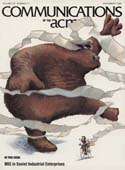November 1986 - Vol. 29 No. 11

Features
MIS in Soviet industrial enterprise: the limits of reform from above
The USSR has carried out a large-scale program to bring computer-based information systems, called Automated Enterprise Management Systems (ASUPs), to industrial enterprises. This program illustrates the extent to which computer-based information systems are inextricably embedded in the surrounding social, economic, and political systems.
A self-assessment procedure dealing with computer organization and logic design
The report of the ACM Longe-Range Planning Committee: a summary
The Committee evaluates ACM as it exists today, and makes recommendations for the future.
Schematic pseudocode for program constructs and its computer automation by SCHEMACODE
To achieve program control flow representation that is relatively independent of any given programming language, schematic pseudocode (SPC) uses a perceptual notation system composed of schemata whose syntax rules are described by a grammar. Source code documentation is supported by operational comments, and translation into a target procedural language is fully automatic.
Spreadsheet calculations of probabilities from the F, t, χ2, and normal distribution
By computing probabilities from the normalization of the F distribution (instead of by numerical integration methods), statistical capabilities in spreadsheet operations can be greatly expanded and enhanced.
A series of three laboratory experiments were conducted to assess the influence of graphical and color-enhanced information presentation modes on decision quality, decision making time, use of information, and user perceptions. The experimental design allowed for the unconfounded study of line graphs and color using a variety of information presentation designs for the same decision making task. Based on the findings of these studies, propositions about the impact of graphics and color on individual decision makers are presented. The influence of presentation mode on human performance and the perceived value of information is related to how well it supports the solution approach to a particular task. The benefits of graphics are limited to reducing decision making time but only when the graphical report has been designed to directly assist in solving the task. Multicolor reports aid in decision making, but only in specific circumstances, that is, their benefits are not pervasive. It appears that color is more advantageous when associated with graphical reports, for certain decision maker types, during learning periods, and in time constrained environments.



